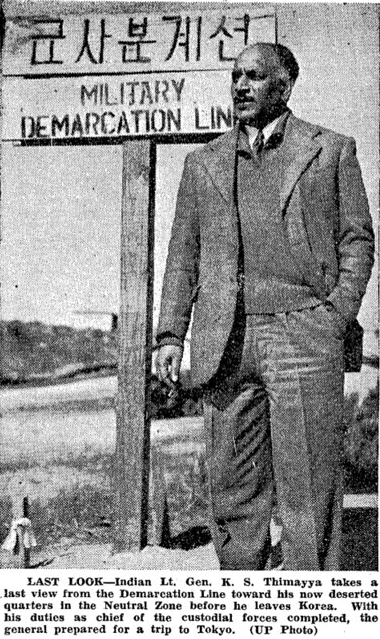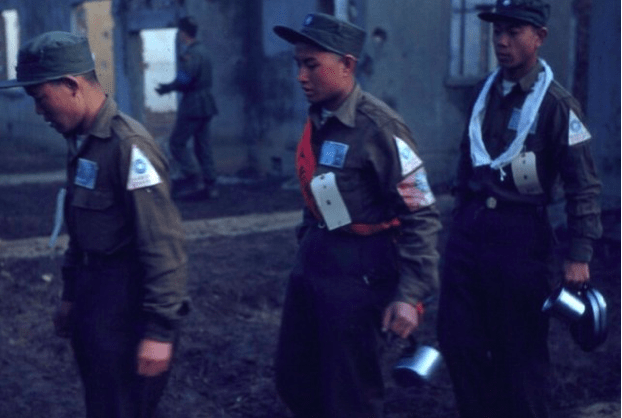Kodandera Subayya Thimayya, popularly known as ‘Timmy,’ was the third of six children born to Subayya and Sitamma. His father, Subayya was a rich coffee planter of the Cheppudira clan in Madikeri in the district of Kodagu. His mother, Sitamma, was a highly educated social worker, who was awarded the Kaisar-e-Hind Medal, in recognition of her work in public service. Many years later, his wife, Mrs Nina Thimayya was also awarded the Kaiser-e-Hind for services rendered while in Quetta.
Both Timmy’s elder brother and younger brother rose to become officers in the Indian Army. His elder brother Ponnappa later joined the INA inspired by Subhas Chandra Bose and his younger brother was Killed in Action (KIA) in the first war in Kashmir. This is an account of the sterling role played by General Thimayya as Chairman of the Neutral Nations Repatriation Commission (NNRC) in Korea.
Early Life and World War II
Thimayya did his schooling in Bishop Cotton School, Bangalore, before enrolling at the Prince of Wales Royal Indian Military College (RIMC) in Dehradun. He was one of six Indian cadets chosen to attend the Royal Military Academy at Sandhurst along with Gen PN Thapar who would later succeed him as the Indian Army Chief in 1961 and be made a scapegoat for failures in 1962.
After graduating from Sandhurst in 1926, he was commissioned into the British Indian Army. While serving with the Scottish 2nd Highland Infantry Regiment stationed in Baghdad, Iraq, he led an operation into King Faisal’s palace to rescue a group of women that were supposedly being victimised. That earned him a certain measure of acclaim. In the 1930’s he was posted in what is now Pakistan’s Khyber Pakhtunkhwa in Pakistan and spent a lot of time battling the Pashtuns.

He took part in World War II and was awarded the Distinguished Service Order (DSO) — an award for meritorious or distinguished service by officers of the armed forces during wartime, typically in actual combat. On promotion to Brigadier, he became the first Indian to command an Infantry brigade—the 268th Indian Infantry Brigade—part of the post-World War II British Commonwealth Occupation Force in Japan. When the war ended, Gen Thimayya was the Indian signatory to the Japanese surrender at Singapore.
Operations in Kashmir
Post Independence, General Thimayya was chosen to lead the counteroffensive in Kashmir and headed the Jammu &Kashmir Force from April 1948. The J&K force was split as Srinagar and Jammu Division and Gen Thimayya headed the Srinagar Division in May 1948. Immediately he set about recapturing territories lost to the marauders with his daring and dynamic brigade commanders, Brig LP Sen of 161 brigade in Uri Sector, Brig Atal of Para Brigade tasked to recapture Zojila and Brig Harbaksh Singh in command of 163 Brigade in Handwara, Kupwara.
They were on a recapturing spree when Nehru decided to unilaterally declare the suspension of operations as the case was referred to the UN much to the protestations of the army brass. Fortunately, Pakistan didn’t comply with the UN resolution allowing the recommencement of operations.
Post Independence, General Thimayya was chosen to lead the counteroffensive in Kashmir and headed the Jammu &Kashmir Force from April 1948.
This window of opportunity was quickly seized by General Thimayya and led to the consolidation of Ladakh with the capture of Zojila, Dras and Kargil. Leh, a weakly held garrison was saved by the sheer audacity and courage of Thimayya and Air Cmde Mehar Singh who landed in a Dakota together for the first time in Leh, paving the way for beefing up troops that saved the town from falling into enemy hands. In another audacious move for the capture of Zojila, tanks of 7 Cavalry were used in a direct firing role which completely destroyed the enemy morale leading to its capture.
Thus Ladakh was saved in the nick of time by November 1948 before winter set in. Seeing the change in pace and tempo of operations, Pakistan quickly agreed to the terms of the UN resolution calling for a ceasefire before it lost all other territories held by them. The rest is history but what stood out is the sheer character and audacity which made Thimayya a national hero for saving Kashmir.
Thimayya and the NNRC
India became a member of the United Nations when it was founded on 24 October 1945. Since its establishment, the UN has had a mixed track record, established as it was to ensure world peace as a primary goal, though it had other subsidiary aims and goals too. One of the early successes of the UN was bringing closure to the Korean War.
India played an important role in bringing the conflict to a speedy conclusion by advocating against a policy being debated at the UN which could have led to the war’s prolongation or escalation. This was indeed a very credible achievement as it was India’s first assignment as an independent country on the world stage. It was also the first time that the Indian Army was deployed for such a mission post-independence.

The Korean War began on 25 June 1950 and raged on for three long years before it was brought to a close by mid-1953. The US-led a Western alliance under a UN resolution called the UN Command, against the Socialist alliance of North Korea and China (known as the Korean People’s Army (KPA) and the Chinese People’s Volunteers (CPV)), supported by the Soviet Union. The ceasefire between the two sides came about as a military stalemate had been reached. Perhaps the war could have ended a year earlier if the peace talks held at Panmunjom on 25 October 1951 could have reached a decision on the question of exchange of prisoners.
It was towards this contentious topic that India suggested a solution which subsequently received near-unanimous support by the UN, and paved the way for allowing for the signing of the Korean Armistice Agreement on 27 July 1953. This was after many efforts by India to suggest a compromise solution had floundered, which increased tensions between India and the United States, and even with South Korea. The US had reasons to suspect Indian neutrality as India was among the first countries to recognise China diplomatically, even advocating for their seat at the UN in 1950.
The prisoner exchange deal was the major issue of contention that defied agreement. There were about 200,000 Chinese and Korean prisoners held by the UN Command and many of these prisoners refused to return to their original countries. There were also some American and Korean prisoners held by the Korean People’s Army (KPA) and the Chinese People’s Volunteers (CPV). A portion of the prisoners had been exchanged and repatriated in April-May 1952, most of whom were wounded and sick in what was then termed as Operation Little Switch.

The Armistice agreement stipulated that a Neutral Nations Repatriation Commission (the NNRC) would be established with two countries from each bloc, and headed by India—underscoring India’s reputation as a neutral country. Accordingly, the NNRC had Czechoslovakia and Poland from the Eastern bloc and Sweden and Switzerland from the West. India was also tasked with providing a brigade of soldiers to provide security for the prisoner exchange. The NNRC was to decide the fate of the remaining prisoners and their repatriation—also called the Big Switch.
The solution included handing over these prisoners to the NNRC headed by India. A full Indian contingent of nearly 6000 personnel called Custodian Force of India (CFI) was to take over physical custody of these prisoners. 190 Brigade under Brig Rajinder Singh Paintal was the central force within the CFI, which also had a large component of civilians. To this was added the 60 Para Field ambulance, which was already in Korea and some additional infantry battalions from India.
This was India’s initiation into peacemaking and conflict resolution. General KS Thimayya was nominated as the Chairman of the Neutral Nations Repatriation Commission (NNRC) and Mr B.N. Chakravarty, IFS, as the Alternate Chairman. The CFI was headed by Maj Gen SPP Thorat. The NNRC through CFI was responsible for gathering non-repatriated prisoners into camps; that included nearly 170,000 prisoners held by UN forces who didn’t want to return to either China or North Korea.
In the face of Chinese demands for the forceful repatriation of their soldiers, the UN and the CFI worked hard to explain to each prisoner their rights and privileges; they could then choose to go home or remain with the side that captured them. This called for compassion, fairness, and neutrality on the part of the Indian Custodian Force, who rendered yeoman service during the entire span of their mission from September 1953 to March 1954. On several occasions, intricate situations were resolved only because of the patience and tact of Lieutenant General KS Thimayya and Major General SPP Thorat. They proved their mettle, earning well-deserved praise for their command and for India.
It was an unenviable task; in the end, only less than 100 who wished not to be repatriated to either country came back to India once the NNRC and CFI concluded their operations. A few Koreans chose to resettle in India, while others were repatriated to Brazil.
On several occasions, intricate situations were resolved only because of the patience and tact of Lieutenant General KS Thimayya and Major General S P P Thorat. They proved their mettle, earning well-deserved praise for their command and for India.
Those who had opined that because of its layered complexities and intrigue, India would not be up to the mark in handling as sensitive an assignment as the NNRC, were proved wrong by the dexterous manner in which the entire matter was handled and flawlessly executed to the satisfaction of all parties concerned, justifying the Indian government’s faith in General Thimayya. His ability to project India’s honour was on full display during his handling of the NNRC in Korea.
Return to India and Promotion to Army Chief
On return to India, Gen Thimayya was honoured with the award of Padma Bhushan. He was appointed the Indian Army Chief on 7 May 1957 and continued in that appointment till his superannuation on 7 May 1961. An interesting anecdote that revolves around him is the detention of a senior politician’s son after he and some goons passed lewd remarks and even tried to molest the wife of an Army officer of 5 JAT in Amritsar in 1959.
With the personal involvement of none less than that of the CM of Punjab, the ripples of this action went up to Parliament. General Thimayya was summoned for an explanation and his response that silenced the opposition was “If we cannot defend the honour of our women, how can you expect us to defend the honour of our country?”
One of the most loved generals of the Indian Army, General Thimayya is not only an Indian military hero he is also a hero of the Korean War. It has been 66 years since the end of the Korean war but even till day, he is remembered by Koreans with gratitude and affection. After his retirement, the UN again requested for his service in 1964 to command UN troops operating on Cyprus in keeping with his reputation of impartiality displayed in Korea. He would, however, die of a massive heart attack on 18 December 1965 at the age of 59.
Col DPK PILLAY, SC, PhD is a decorated war veteran from the Brigade of Guards. He served as Senior Defence Specialist at the National Security Council Secretariat (NSCS) before joining MPIDSA as a Research Fellow. He was alsoa Military Advisor with the ICRC for an After Action Review for Iraq Syria and Yemen.


